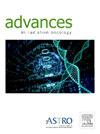不旋转患者床的非共面VMAT与传统共面/非共面VMAT治疗头颈癌的剂量学比较:动态摆动弧的首次报道
IF 2.2
Q3 ONCOLOGY
引用次数: 0
摘要
目的:本回顾性计划研究旨在验证一种临床可用的方法,动态摆动弧(DSA),一种非共面体积调制弧治疗(VMAT)技术,新型加速器OXRAY治疗头颈部鳞状细胞癌(HNSCC)的有效性。我们对DSA和传统的共面/非共面VMAT (C-VMAT/NC-VMAT)治疗HNSCC进行了剂量学比较。方法和材料我们选择了2018年9月至2023年7月在国家癌症中心东医院接受C-VMAT治疗的32例口咽和下咽癌患者。分别使用OXRAY和TrueBeam生成DSA和C/NC-VMAT图。DSA采用非共面2圆弧梁和o型环龙门摆梁,而C-VMAT和NC-VMAT分别采用共面和非共面2圆弧梁。使用带Bonferroni校正的Wilcoxon符号秩检验对剂量学参数、正常组织并发症概率和递送时间进行两两比较。结果对于高危计划靶体积(PTV), NC-VMAT方案的D98值最接近处方剂量,与C-VMAT和DSA方案差异显著。与C-VMAT(0.95和8.36)和NC-VMAT(0.96和7.96)计划相比,DSA计划的中位一致性和均匀性指数(分别为0.97和7.33)明显更好。与C-VMAT和NC-VMAT相比,DSA计划显著降低同侧/对侧腮腺平均剂量5.78/6.93 Gy和2.88/1.56 Gy(中位数)。与C-VMAT相比,NC-VMAT和DSA计划显著降低了平均口腔剂量2.16 Gy和3.22 Gy(中位数)。DSA方案的正常组织并发症中位数最低,差异有统计学意义,其次是NC-VMAT方案和C-VMAT方案。DSA计划的交付时间比VMAT(151秒比124秒)长,但比NC-VMAT短。结论与共面VMAT计划相比,使用OXRAY的sdsa计划在减少腮腺和口腔平均剂量的同时,维持了HNSCC的PTV覆盖率,尽管交付时间增加了。与非共面VMAT计划相比,DSA计划减少了腮腺剂量和给药时间。本文章由计算机程序翻译,如有差异,请以英文原文为准。
Dosimetric Comparison of Noncoplanar VMAT Without Rotating the Patient Couch Versus Conventional Coplanar/Noncoplanar VMAT for Head and Neck Cancer: First Report of Dynamic Swing Arc
Purpose
This retrospective planning study aimed to verify the usefulness of a clinically available method, dynamic swing arc (DSA), a noncoplanar volumetric modulated arc therapy (VMAT) technique, of the new accelerator OXRAY for head and neck squamous cell carcinoma (HNSCC). We performed dosimetric comparisons between DSA and conventional coplanar/noncoplanar VMAT (C-VMAT/NC-VMAT) plans for HNSCC.
Methods and Materials
We selected 32 patients with oropharyngeal and hypopharyngeal cancer treated with C-VMAT at National Cancer Center Hospital East between September 2018 and July 2023. DSA and C/NC-VMAT plans were generated using OXRAY and TrueBeam, respectively. DSA employed noncoplanar 2-arc beams with an O-ring gantry swing, whereas C-VMAT and NC-VMAT used coplanar and noncoplanar 2-arc beams, respectively. Dosimetric parameters, normal tissue complication probability, and delivery times were compared pairwise using the Wilcoxon signed-rank test with Bonferroni correction.
Results
For high-risk planning target volume (PTV), D98 values in NC-VMAT plans were closest to the prescribed dose, significantly differing from C-VMAT and DSA plans. DSA plans showed significantly better median conformity and homogeneity indices (0.97 and 7.33, respectively) compared to C-VMAT (0.95 and 8.36) and NC-VMAT (0.96 and 7.96) plans. DSA plans significantly reduced the mean ipsilateral/contralateral parotid gland dose by 5.78/6.93 and 2.88/1.56 Gy (median) compared to C-VMAT and NC-VMAT. NC-VMAT and DSA plans significantly decreased the mean oral cavity dose by 2.16 and 3.22 Gy (median) compared to C-VMAT. DSA plans had the lowest median normal tissue complication for xerostomia with significant differences, followed by NC-VMAT and C-VMAT. The delivery time for DSA plans was longer than VMAT (151 seconds vs 124 seconds), but shorter than NC-VMAT.
Conclusions
DSA plans using OXRAY for HNSCC maintained PTV coverage while reducing parotid gland and oral cavity mean doses compared to coplanar VMAT plans, although delivery times increased. DSA plans reduced parotid gland doses and delivery times compared to noncoplanar VMAT plans.
求助全文
通过发布文献求助,成功后即可免费获取论文全文。
去求助
来源期刊

Advances in Radiation Oncology
Medicine-Radiology, Nuclear Medicine and Imaging
CiteScore
4.60
自引率
4.30%
发文量
208
审稿时长
98 days
期刊介绍:
The purpose of Advances is to provide information for clinicians who use radiation therapy by publishing: Clinical trial reports and reanalyses. Basic science original reports. Manuscripts examining health services research, comparative and cost effectiveness research, and systematic reviews. Case reports documenting unusual problems and solutions. High quality multi and single institutional series, as well as other novel retrospective hypothesis generating series. Timely critical reviews on important topics in radiation oncology, such as side effects. Articles reporting the natural history of disease and patterns of failure, particularly as they relate to treatment volume delineation. Articles on safety and quality in radiation therapy. Essays on clinical experience. Articles on practice transformation in radiation oncology, in particular: Aspects of health policy that may impact the future practice of radiation oncology. How information technology, such as data analytics and systems innovations, will change radiation oncology practice. Articles on imaging as they relate to radiation therapy treatment.
 求助内容:
求助内容: 应助结果提醒方式:
应助结果提醒方式:


